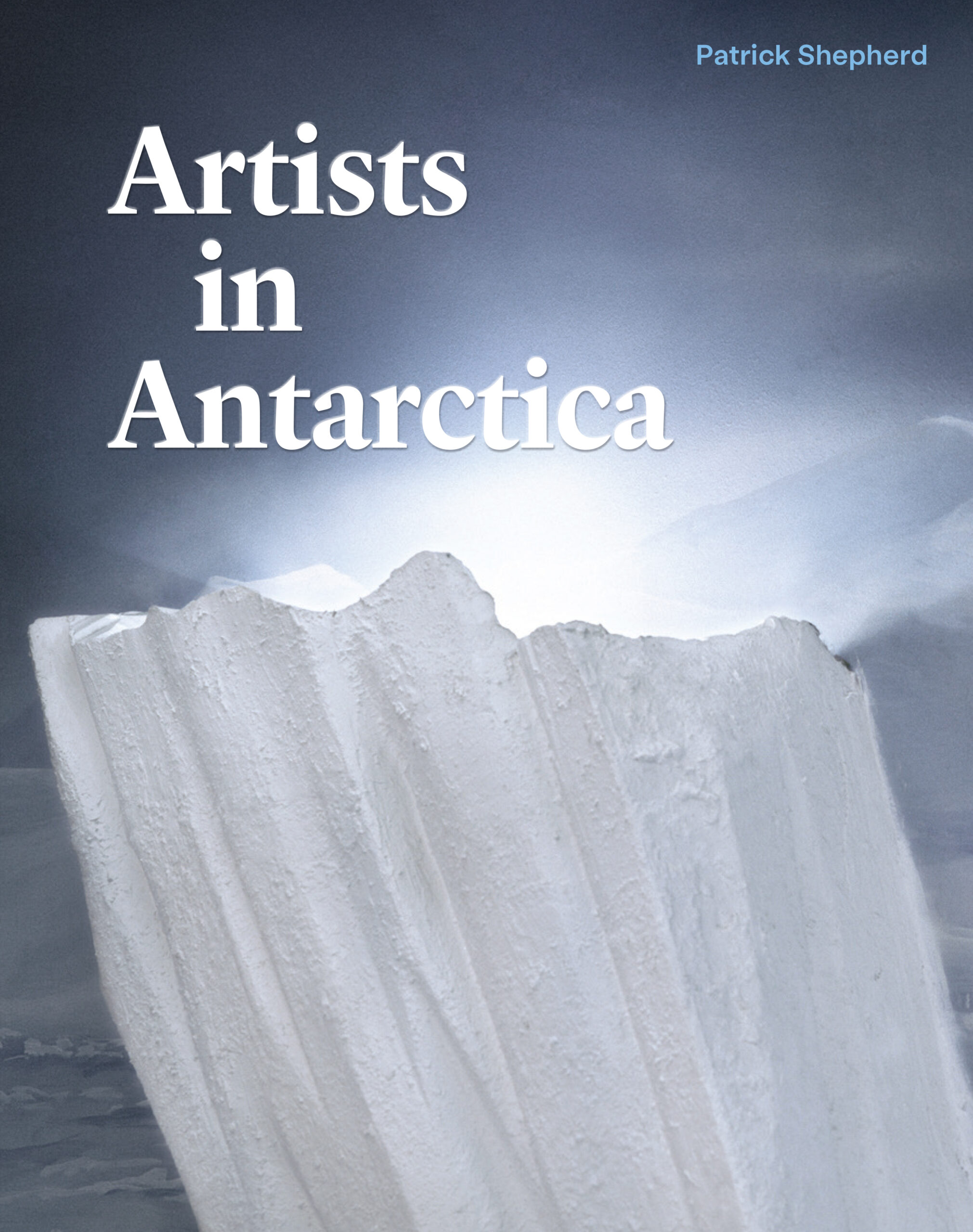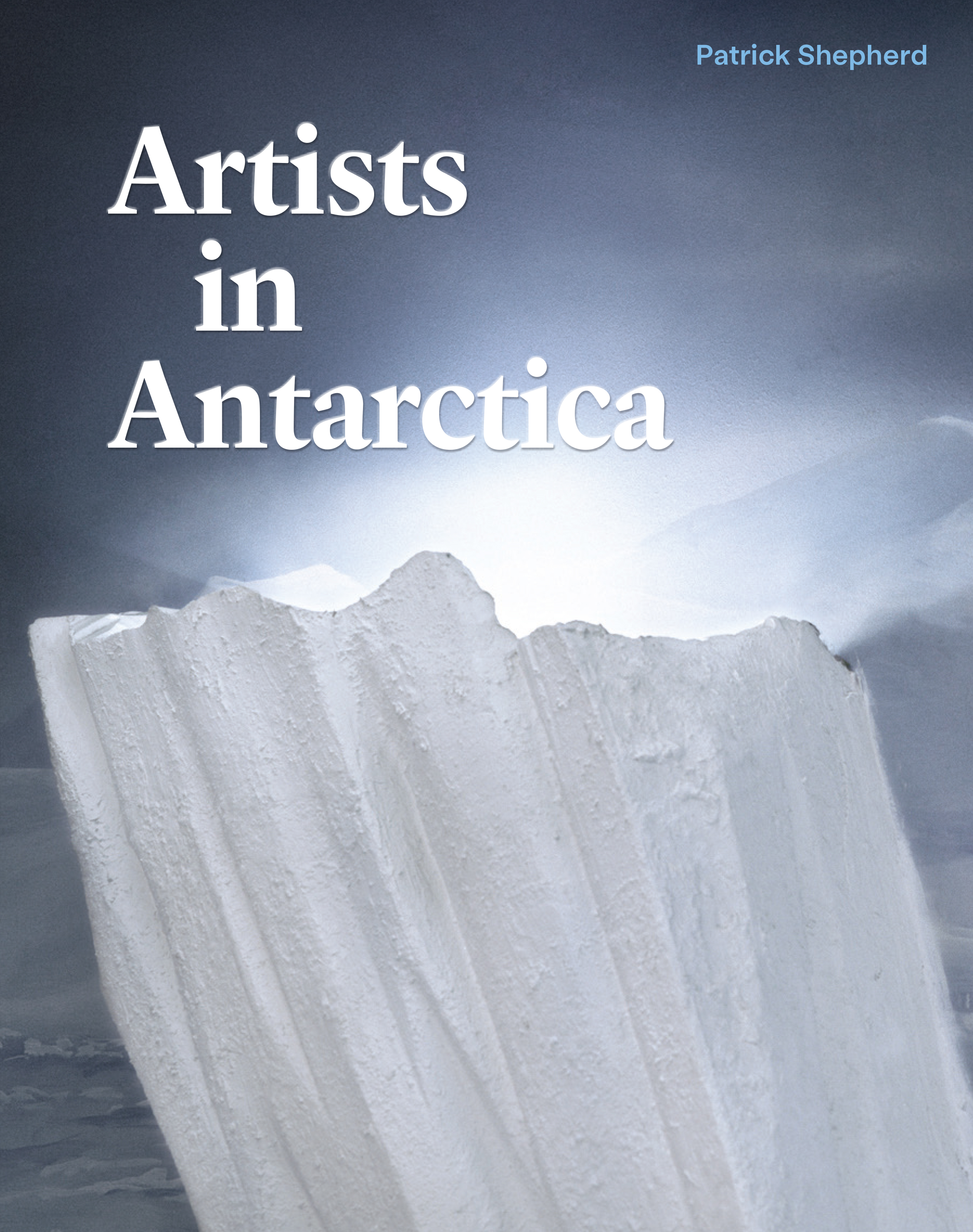Artists in Antartica

Artists in Antarctica edited by Patrick Shepherd. MUP (2023). RRP: $80. HB, 240pp. ISBN: 9781991016270. Reviewed by James Norcliffe.

I couldn’t help but gather adjectives from the first few pages of this handsome book: brutal, fearsome, desolate, hostile, extreme, unforgiving, bleak, inhospitable, unpredictable, forbidding… There is in fact a thesaurus load of such adjectives to describe Antarctica, our near neighbour to the south. Time and time again, the nearly forty artists featured in the book underscore and develop this theme.
Simply put, the Antarctic is not a place at all suited for human habitation. Surviving in Antarctica originally demanded tremendous fortitude and endurance; today it still requires these qualities albeit tempered by space-age technology and all the resources of the modern state.
Even so, visiting demands you live, as Gareth Farr the composer, puts it, in ‘a space-station-like environment’ (p.92). ‘Everything there’ says jeweller Kirsten Haydon, ‘is fundamental’ (p.113). ‘I felt,’ said Graeme Sydney, ‘I was on another planet’ (p.206). And as the editor – or perhaps curator – of the book, artist and composer Patrick Shepherd says, ‘There are constant reminders that we’re not supposed to be there…’ (p.194).
All of the showcased artists would agree with these sentiments, but at the same time, all agreed to take up the offer to go to the frozen continent to experience first-hand its rigours and its wonders and be inspired by these to create works of art.
The offers to the artists came from Antarctica New Zealand’s Community Engagement Programme, formerly the Artists to Antarctica and Invited Artists Programme. We are told that more than one hundred artists over a field of artistic expression have visited Scott Base since 1957. Patrick Shepherd has gathered thirty-seven of these, including painters, fiction writers, poets, photographers, composers, dancers, and multi-media artists to share a sample of their work and to comment on their experience in the few days they spent on the ice.
The result is a sumptuous collection of images and writing: a beautiful book to dip into or to devour in one sitting. There is a useful introduction by the editor on the background to the arts on the frozen continent and the nature of the programme, a theme developed by Adele Jackson in her historical survey of Aotearoa’s Antarctic arts and cultural heritage. Much is made in the book of the synergies possible when science meets art and the book is testament to these possibilities. Of course, once the first wave of exploration-driven visitors had their day, scientific examination reigned supreme. The earliest visitors, from Cook onwards, have given us the near legendary stories of heroism, fortitude and tragedy that still resonate today. Amundsen, Scott, Titus Oates, Evans, Wilson, Shackleton, Mawson and those of their time still tower tall in the public imagination and they have a presence here in the book as well. It would be hard to be otherwise when the dry, frozen conditions have preserved both Scott’s and Shackleton’s huts, the first at Hut Point and Cape Evans and the latter at Cape Royds. For the participants, visiting these huts and looking at the artifacts they contain was an eerie experience, almost as though not only was the landscape frozen, but time had been frozen as well.
Each of the artists was granted four or five pages to recollect and reflect on the experience and to share a sampling of the work resulting from it. It was clear that Patrick Shepherd had prompted the recollections with a short template: initial impressions, actual experience and lasting effects on their work of what for many was a life-changing experience. This might have made for a somewhat mechanical patterning, but given that these were thirty-seven highly individual and very talented artists the responses were intriguing and fascinating. Those included were ordered alphabetically, not chronologically or by genre, and this resulted in a pleasing variety. It was perhaps fortuitous that Laurence Aberhart, photographer should have opened the proceedings given that his signature monochrome photographs are taken with an 8 X 10-inch view camera, with a similar-sized negative. As Aberhart says, ‘it’s the same camera that Ponting and Hurley used in their pioneering photography on the Terra Nova and Endurance expeditions in the early 1900s; it’s the same technology’ (p.35). Thus a serendipitous bridge directly to the hi-tech photographs of Andris Apse and thence to the remaining artists.
Antarctica for so many of the artists was an overwhelming experience. It was difficult to come to grips with its sheer size, with the knowledge that the vast hinterland of Scott Base was only a tiny corner of the continent. One way of coping with this overpowering landscape was to focus instead on the small things, the manageable, the minutiae and the human. The bunk room, the signal flags on the ice, the artifacts in the huts of the first explorers. There are a number of references in different works to the poetically named lamp oil ‘Homelight’, a crate of which features in a Dick Frizzell painting of the interior of Shackleton’s hut.
It is, of course, impossible to generalise regarding individual perceptions and reactions given the wide range of artists concerned and the circumstances of their visits. Many had specific projects in advance, others developed responses retrospectively. There were collaborations; and some visitors were part of a small group – one or two others – and these allowed for cross fertilizations. For example, the poets Bill Manhire and Chris Orsman shared with the painter Nigel Brown, and the poet Bernadette Hall coupled with the painter Kathryn Madill. Such groupings produced memorable work as the participants found common artistic ground and in some cases, as with Hall and Madill, continued their friendship and collaboration long after.
One final question most of the artists responded to was whether they’d like to return. Some wanted to and many in fact did, for others once was enough. It was such a transcendent experience it couldn’t really be added to.
While not an equivalent transcendent experience, Artists in Antarctica is a beautiful, elegantly-designed book that gives the reader just a glimpse of the majesty and mystery of the southern continent.
It should be noted, finally, that so many of the participants expressed anxiety about the dangers to the Antarctic of unchecked global warming. Vast and majestic, but also fragile. Even between reading the book and writing this review have come reports of great swathes of the Ross Ice Shelf breaking off into the sea.
I do trust that Artists in Antarctica is a record of what is, not of what used to be.
James Norcliffe has published eleven collections of poetry including Shadow Play (2013), Dark Days at the Oxygen Café (VUP, 2016), Deadpan (OUP, 2019) and this year’s Letter to Oumuamua (OUP). Last year he was awarded the NZ Prime Minister’s Award for Literary Achievement in poetry.